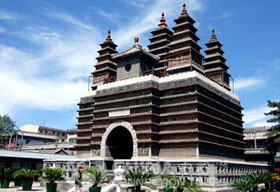 Five Pagoda Temple, also called Jingangzuo Sheli Baota, seated in Wuta Jie, the southeastern part of the old town, and is a miniature temple built in Indian style. Originally the temple was used by followers and monks as a stuppa for relics and was, up until the Qing Dynasty (1644-1911 AD), a part of a larger complex, the Ci Deng Temple (Ci deng si). It is one of the only remaining parts of the original Ci Deng Temple compound located in the Old City of Hohhot. It stands amongst the ruins of old courtyard homes, which are being torn down to make way for new apartment buildings and a new way of life. It is part of what was once known as "Temple City", having over 200 temples in this area.
Five Pagoda Temple, also called Jingangzuo Sheli Baota, seated in Wuta Jie, the southeastern part of the old town, and is a miniature temple built in Indian style. Originally the temple was used by followers and monks as a stuppa for relics and was, up until the Qing Dynasty (1644-1911 AD), a part of a larger complex, the Ci Deng Temple (Ci deng si). It is one of the only remaining parts of the original Ci Deng Temple compound located in the Old City of Hohhot. It stands amongst the ruins of old courtyard homes, which are being torn down to make way for new apartment buildings and a new way of life. It is part of what was once known as "Temple City", having over 200 temples in this area.
Tibetan Buddhism still has a stronghold in this city, especially amongst the Mongolian people. Since the temple stood on a high platform and was crowned with 5 little pagodas, built in the Qing Dynasty (1644-1911), 13 meters high and built of bricks. The five standing side by side on a base, the central pagoda has seven floors, while the rest on the four corners are all five floors, so it is also called "Five-Pagoda Temple". The temple was composed of three parts-the front, the middle and the rear. There are various kinds of Buddha figures and scripts carved on the surface of the Pagoda. Although it is called the "1000-Buddha Pagoda", there are actually some 1563 carvings of Buddha on its exterior walls, which draw both tourists and locals alike to come and pray. On the screen wall behind the pagoda are 3 liner carved pictures. The one in the center is mountain Xumi's distribution map. The one to the right refers to "reincarnation into six kinds of beings" and the one to the left is the only astronomical map of more than 1,550 stars with explanation in Mongolian. This map is of great value both in scientific and historic studies.

